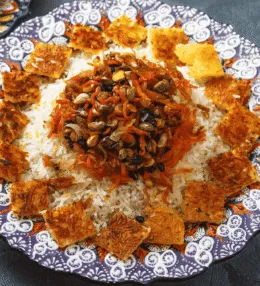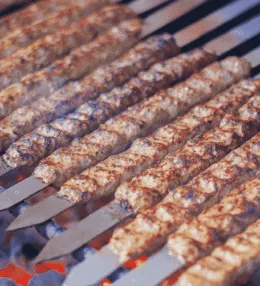
- View
Table of Contents
ToggleCrumpets are a breakfast favourite across Britain, equally at home on a busy weekday or a lazy weekend. They look humble yet feel luxurious once toasted, with butter slipping through their little tunnels and pooling on the plate. Add jam or marmalade if you like, though good butter alone does the job.
Part bread, part griddle cake, a crumpet gives gentle chew with a honeycombed top that turns lightly crisp under heat. That contrast is the joy. The first bite releases steam and a soft whiff of yeast, then comes butter and salt, then whatever topping you fancy.
They suit everyday life. Crumpets take well to quick toasting, feed children happily, and carry sweet or savoury toppings with ease. Cheese melts across the surface like lace; honey flows into the holes; a poached egg turns it into a small but satisfying supper.
Want to dive deeper into British Cuisine? Don’t miss our post on Traditional British Foods to Try
What is a Crumpet?
A crumpet is a batter bread cooked on a hot plate or thick pan using metal rings to keep a tidy round shape. The batter is wetter than a standard bread dough and rises with yeast. As it cooks from below, bubbles burst on the surface and set into neat holes that invite butter in.
Unlike an English muffin, which is split before toasting, a crumpet is served whole and toasted on both sides. The base becomes golden and firm, while the top stays tender yet sturdy. Those holes are not decoration; they are flavour carriers built by steam and yeast.
The method is simple once you know the rhythm. Pour batter into rings, let bubbles rise and dry on top, then flip briefly to colour the base. The aim is a soft interior with a delicate crust. Eat fresh from the toaster for peak comfort.
Ingredients and Taste
Core ingredients are plain flour, warm milk or water, yeast, a pinch of sugar to wake the yeast, and salt for balance. Some cooks add a little bicarbonate mixed with water for extra lift and a pale tender crumb. A smear of butter on the pan helps the edges colour nicely.
Freshly made crumpets taste faintly tangy from the yeast and gently sweet if a touch of sugar is used. Toasting brings a nutty aroma and a whisper of crispness. Butter melts through the holes to enrich every mouthful, while jam, honey, or cheese change the mood in quick strokes.
Savoury treatments are equally rewarding. Try a swipe of Marmite for a deep savoury hit, or top with ripe tomatoes and cheddar under the grill. For breakfast, set one beside scrambled eggs; for tea, add lemon curd; for late evenings, a quiet splash of honey does wonders.
A Taste of History
Crumpets trace their roots to griddle breads cooked on open hearths in the British Isles. Early versions were likely thinner and more like pancakes. By the nineteenth century, yeast raised crumpets with a characteristic porous top had become a feature of urban tea tables and railway station buffets.
The metal ring changed everything by giving a reliable round and a deeper rise. Industrial baking later brought packet crumpets to homes across the country, while cafés kept the handmade style. Regional names and recipes varied, yet the idea remained the same, a warm bread for quick comfort.
Today the crumpet sits in that small club of foods that are everyday yet cherished. You find them in supermarkets, bakeries, and home freezers, ready for toasting when the kettle goes on. One bite and the appeal is clear, gentle chew, butter-soaked crumb, and a friendly hit of warmth.
How to Make Crumpets (Griddle Cakes)
Crumpets are one of Britain’s most beloved griddle cakes, with their signature golden base and soft, hole filled tops that soak up butter and jam beautifully. This recipe walks you through the simple yet rewarding process of creating them at home, from preparing the yeast batter to cooking them gently on the griddle. Expect a light, spongy texture with a crisp underside that captures the essence of an authentic English teatime. See the recipe card at the bottom for printable directions
Ingredients
- 450 g strong plain flour
- 350 ml warm milk
- 150 ml warm water
- 1 tsp caster sugar
- 1 tsp salt
- 2 tsp dried active yeast
- 1 tsp bicarbonate of soda
- A little vegetable oil or butter for greasing rings and pan
Cooking Instructions
Step 1: Prepare the Yeast
In a jug, combine the warm milk, warm water, and caster sugar. Sprinkle the dried yeast over the surface, stir lightly, and leave for about 10 minutes until frothy. This step ensures the yeast is active and will create the airy bubbles crumpets are known for.
Step 2: Make the Batter Base
Place the flour and salt into a large mixing bowl. Pour in the yeast mixture gradually, whisking until you have a smooth, thick batter. The batter should resemble thick cream with no lumps. Cover the bowl with a cloth and let it rest in a warm spot for 1 hour until doubled in size.
Step 3: Activate with Bicarbonate of Soda
After resting, mix the bicarbonate of soda with 2 tbsp warm water and stir it into the risen batter. This encourages more bubbles and ensures the crumpets form their classic holes on top. Leave to rest for another 20 minutes.
Step 4: Prepare the Cooking Surface
Lightly grease a heavy non-stick frying pan or griddle and place it over medium to low heat. Also, grease metal crumpet rings with butter or oil to prevent sticking. Place the rings on the hot pan to warm slightly before adding the batter.
Step 5: Cook the First Side
Spoon batter into each ring until about half full. Cook gently for 7 to 10 minutes without moving them. Small holes should appear on the surface as the batter sets. If the top still looks wet, continue cooking until nearly set.
Step 6: Release from the Rings
Once the tops are almost firm, carefully lift off the rings with tongs or a cloth. If they stick, run a knife gently around the inside of the ring. This allows the crumpets to cook more evenly as they finish setting.
Step 7: Flip for a Light Finish
Turn the crumpets over carefully and cook for another 1 to 2 minutes until lightly golden on the other side. The base should be crisp while the top remains soft and spongy. Transfer to a wire rack to cool slightly.
Step 8: Continue Cooking the Batch
Grease the rings again and repeat the process with the remaining batter. Keep cooked crumpets warm by covering them with a clean towel or placing them in a very low oven.
Step 9: Serve the Crumpets
Enjoy the crumpets warm, split open or whole, spread generously with butter so it melts into the holes. They pair beautifully with jam, marmalade, or even savoury toppings like cheese. Present on a warm plate for the full teatime experience.
Variations and Substitutions
- Flour: If strong flour is not available, plain flour can be used, though the texture will be slightly less chewy.
- Yeast: Fresh yeast can be substituted for dried yeast using 15 g dissolved in the warm liquid.
- Milk: Plant based alternatives like oat or almond milk can replace cow’s milk if required.
- Rings: If you do not have crumpet rings, cleaned tuna tins with both ends removed can work as a substitute.
Cooking Tips for Perfect Crumpets
- Keep the heat low to medium so the bottoms do not burn before the tops set.
- Always rest the batter long enough for the yeast and bicarbonate to do their work. Rushing will result in dense crumpets.
- Lightly oiling rings between batches prevents sticking and preserves the shape.
- Crumpets freeze well. Cool completely, then store in freezer bags. Reheat directly from frozen in a toaster.

Crumpets (Griddle Cakes)
Ingredients
- 450 g strong plain flour
- 350 ml warm milk
- 150 ml warm water
- 1 tsp caster sugar
- 1 tsp salt
- 2 tsp dried active yeast
- 1 tsp bicarbonate of soda
- A little vegetable oil or butter for greasing rings and pan
Instructions
- In a jug, combine the warm milk, warm water, and caster sugar. Sprinkle the dried yeast over the surface, stir lightly, and leave for about 10 minutes until frothy. This step ensures the yeast is active and will create the airy bubbles crumpets are known for.
- Place the flour and salt into a large mixing bowl. Pour in the yeast mixture gradually, whisking until you have a smooth, thick batter. The batter should resemble thick cream with no lumps. Cover the bowl with a cloth and let it rest in a warm spot for 1 hour until doubled in size.
- After resting, mix the bicarbonate of soda with 2 tbsp warm water and stir it into the risen batter. This encourages more bubbles and ensures the crumpets form their classic holes on top. Leave to rest for another 20 minutes.
- Lightly grease a heavy non-stick frying pan or griddle and place it over medium to low heat. Also, grease metal crumpet rings with butter or oil to prevent sticking. Place the rings on the hot pan to warm slightly before adding the batter.
- Spoon batter into each ring until about half full. Cook gently for 7 to 10 minutes without moving them. Small holes should appear on the surface as the batter sets. If the top still looks wet, continue cooking until nearly set.
- Once the tops are almost firm, carefully lift off the rings with tongs or a cloth. If they stick, run a knife gently around the inside of the ring. This allows the crumpets to cook more evenly as they finish setting.
- Turn the crumpets over carefully and cook for another 1 to 2 minutes until lightly golden on the other side. The base should be crisp while the top remains soft and spongy. Transfer to a wire rack to cool slightly.
- Grease the rings again and repeat the process with the remaining batter. Keep cooked crumpets warm by covering them with a clean towel or placing them in a very low oven.
- Enjoy the crumpets warm, split open or whole, spread generously with butter so it melts into the holes. They pair beautifully with jam, marmalade, or even savoury toppings like cheese. Present on a warm plate for the full teatime experience.
Nutrition
You May Also Like







Leave a Review